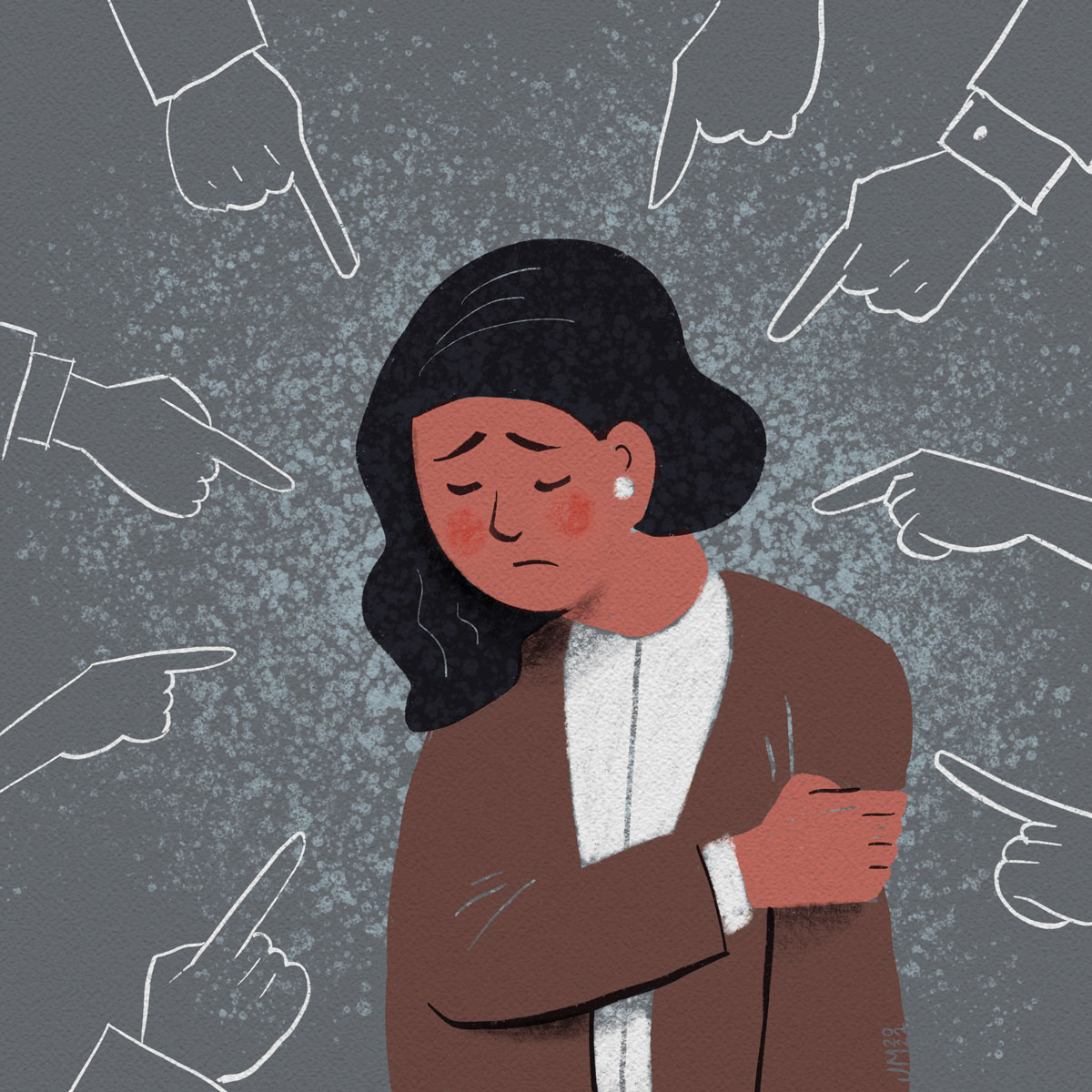Stigmatizing weight makes us more likely to gain weight, not less. It also puts us at risk for depression, self-esteem issues and eating disorders. The next time you feel compelled to comment on someone else’s food choices or body size, do this instead.
When Cathy*, a graduate student studying psychology, flies home to see her mom, the knot in her stomach starts growing on the plane. “If I’ve put on weight, she gets disappointed. She has a look on her face, kind of a forced smile, and I just know what she’s thinking.” Cathy grimaces, remembering a recent interaction. “I hate it. It feels really bad.” If Cathy has lost weight, her mom greets her very differently. “Then she’s all smiles and hugs. So predictable.”

Like many people, Cathy has struggled with her weight since childhood. Her mother also struggled and passed on to Cathy the moral judgments about food and weight that many of us know all too well. We say things like, “I was really bad yesterday, I ate so much junk” or “I was good today, I didn’t cheat at all.” We equate food and weight with being good or bad. We place a moral value on body sizes and shapes.
The price of stigma
When we do this, we set ourselves up for problems. Laboratory experiments show that even just reading articles or watching videos about higher-weight people being discriminated against can lead research participants to eat more calories and feel less in control of their eating [1, 2]. They also have higher cortisol levels than participants who aren’t exposed to information about weight stigma [1]. Cortisol is a stress hormone that may contribute to weight gain [3].
Shaming people for what they eat and how much they weigh doesn’t help them slim down and choose healthier foods. In fact, it appears to do the opposite. Research shows that the more we expose people to weight bias and discrimination, the more likely they are to gain weight and become medically obese–even if they weren’t higher weight to start with [4].
Higher-weight people are at greater risk for developing an eating disorder yet half as likely to be diagnosed [5, 6]. Given that 28.8 million Americans will develop an eating disorder in their lifetime and eating disorders are among the deadliest mental health conditions (second only to opioid overdose), this is a serious problem that deserves our care and attention [7, 8].
For Cathy, getting teased and bullied about her weight in childhood contributed to poor self-esteem and body image issues throughout her life. She started binge eating in high school. It was the only way she knew to try to soothe the emptiness that she felt but couldn’t name. It would take years for her to label those feelings as depression and anxiety and seek treatment for them.
Cathy experienced cycles of intense food restriction and then compulsive overeating. She felt virtuous when she fasted and loathsome when she overate. Without realizing it, Cathy’s family encouraged her to tie her self-worth to her weight. They praised her for losing weight and showed disapproval when she regained it. Desperate to restore their admiration, Cathy would start fasting again.
This is a dangerous cycle that no parent or friend wants to promote. Yet we do it without thinking. We don’t grasp the influence of our comments or the consequences of our judgments. We don’t consider that the critical statements we make about our bodies deeply affect how our kids think about their own bodies. This isn’t to say that our negative comments definitely give our loved ones eating disorders or destroy their self-image, but they might contribute.
So what can we do?
With conscious and repeated effort, we can foster positive feelings about our bodies in ourselves, our children, and everyone around us. Feeling good about our bodies helps us make positive changes and live healthier lives. Our attitudes are contagious, particularly on social media. So be mindful of what you promote in-person and online.
- Avoid making critical statements about your body (or anyone else’s). Focus on what you like about your body and how you look. Instead of saying, “This shirt makes me look fat,” model positive feelings about your body by saying something like, “I like the way this dress looks on me” or “Look how sharp I look in this jacket!”
- Praise internal characteristics, like being creative or hard-working. Compliment people on the chosen aspects of their appearance, like jewelry, clothing, make-up, etc.
- Shift the emphasis away from just how our bodies look and talk about positive things our bodies can do. “Bike riding is so much fun!” or “My body feels so good when I’m swimming.”
- Question media messages. Social media and mass media often promote unrealistic body types. When you watch something with your children, ask questions at the end. What kinds of bodies were portrayed? Were they realistic? Who created the content? How are they making money from these messages?
- Model healthy choices. If you’re trying to eat healthier and be more physically active, focus on what you like about those choices. You might notice that you sleep better, that you feel happier, or that your back feels good. Avoid talking about weight loss. Making healthier choices because it feels good is often more sustainable and motivating than doing it to lose weight or to look a certain way.
- Encourage self-compassion and love for our bodies. Body-positive affirmations can help, such as “My body deserves love” and “I feed my body healthy food and nourishing exercise because it deserves my care.”
Mindful Eating
If you want to manage your food cravings and develop healthier eating habits, mindful eating may help. Mindful eating compels us to slow down and pay attention to how food makes us feel, both physically and emotionally. When we know what feels good, we can more easily make changes and choices that nurture our bodies.
When we practice mindful eating, we focus our full attention on the moment:
- We notice our thoughts, physical sensations, and emotions.
- We take our time and stay relaxed.
- We recognize when we’ve eaten enough and which foods make us feel better physically.
- We derive more pleasure from eating because we focus more deeply on our food.
Mindful Eating Exercises
For You
- If you can, choose a quiet place to eat that is free from distraction. Sit down and take a moment to breathe deeply and ground yourself.
- Take another moment to appreciate the wonderful energy and care that went into producing this food. If you feel inclined, express gratitude.
- Now, engage all your senses and focus on the food in front of you.
- Notice how your food looks—the colors and shapes. What do you see?
- Breathe deeply and regard the smell. Can you smell the individual ingredients? Do you prefer the way certain foods smell over others?
- If you take the food in your hand, how does it feel? Is it warm or cold, hard or soft?
- Close your eyes and put it in your mouth. Before you chew, what’s the first thing you taste? What does it feel like on your tongue? While you chew, notice how tastes and textures change.
- As you continue eating, notice how your stomach feels. Do you feel hungry? Full? Somewhere in between?
- How do you feel emotionally? Content, sad, anxious, relaxed, guilty, satisfied?
- When you feel full, stop eating.
For Children
If you have kids, you can invite them to try mindful eating with you. Explain that you’re going to experience food in a new way, using your five senses and taking small “mindful bites”:
- Sight: What color is it? What shape? What do you notice?
- Touch: Take it in your hand and notice what it feels like. Is it hard or soft? Bumpy or smooth?
- Smell: What does it smell like? How would you describe it?
- Sound: What do you hear? Does it make any sound when you squish it?
- Taste: [Encourage them to close their eyes] Put the food in your mouth but don’t chew yet. What’s the first thing you taste? Is it salty, sweet, sour, or something else? Now chew slowly. Think about the changes in texture, flavor and sounds. Do those things change the longer you chew?
To learn more about mindful eating, HelpGuide provides useful information.
Cathy’s Road to Recovery
Cathy learned about mindful eating from her therapist, and she’s been practicing mindfulness and other coping skills for the past year. Cathy feels better about herself and more capable of practicing eating habits that make her feel good. She says, “I still think about my weight a lot, but I feel more accepting, less all-or-nothing. If I eat too many doughnuts, it doesn’t ruin my day.” She goes on to say, “I sit with it and try to eat mindfully tomorrow.”
As for Cathy’s mom, “She still has her issues, but we’re making progress. Just talking about it has helped. I feel more detached from her judgments, less inclined to eat a whole carton of ice cream just to punish her.” Cathy smiles wryly. Sounds like progress, indeed.
Next Steps
If you or someone you love struggles with disordered eating or body image issues, you might benefit from talking to a professional.
Talk to your doctor or contact Athena Care, for mental health care in Tennessee.
(615) 320-1155
One of our care coordinators will help you get the help you need.
*Cathy’s name and other identifying details were changed to protect her privacy.

Rachel Swan, MS
Editor
Rachel has a Masters of Science in Clinical Psychology from Vanderbilt University, where she spent 16 years as a Research Analyst in the Psychology and Human Development Department.


